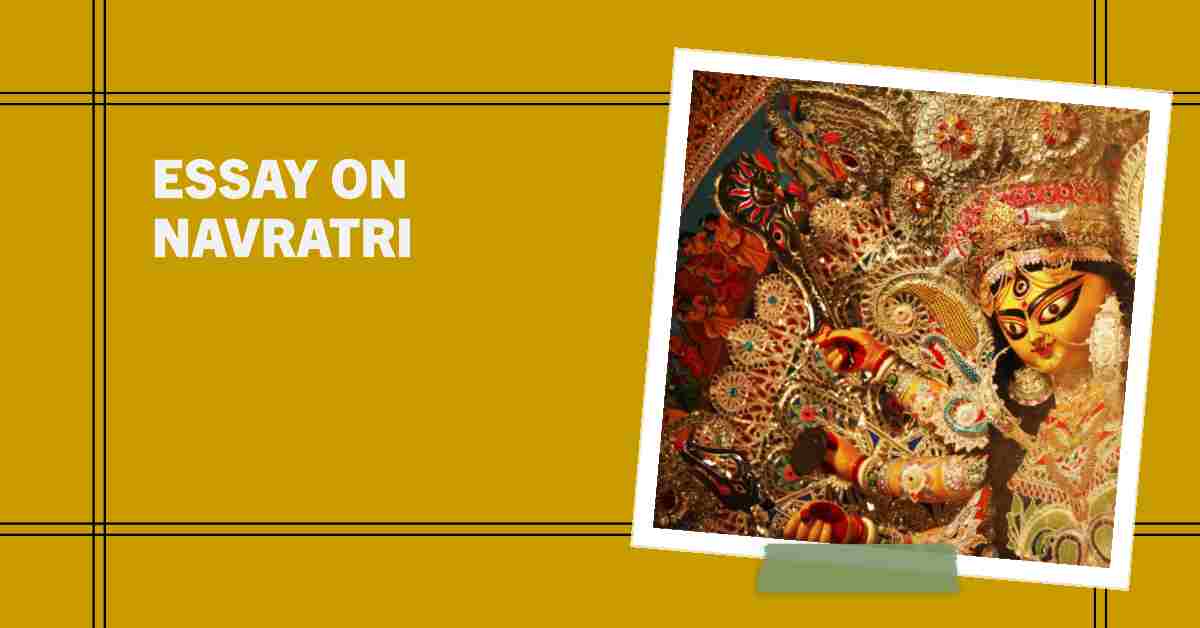3 Sets of Essay On Navratri Festival in 100, 300 and 400 Words
Here, we are presenting long and short Essay On Navratri Festival in English for students under word limits of 100 – 150 Words, 200 – 250 words, and 400 – 500 words. This topic is useful for students of classes 1, 2, 3, 4, 5, 6, 7, 8, 9, 10, 11, and 12 in English. These provided essays will help you to write effective essays, paragraphs, and speeches.
100 Words Essay On Navratri
India celebrates the colorful and joyous festival of Navratri. Every night of the nine-night festival is devoted to a distinct manifestation of the goddess Durga. The celebration honors the victory of good over evil. People dance, make exquisite decorations, and dress in vibrant traditional garb. During Navratri, special dances like Garba and Dandiya are performed. Families get together to eat delicious food, pray, and sing. The celebration fosters a strong sense of community and is a time for joy and getting together. It’s not just about having fun; it’s also a time for introspection and spiritual growth, signifying the triumph of light over darkness.
250 Words Essay On Navratri
Introduction:
The vibrant and lively festival of Navratri is celebrated by Hindus worldwide. The festival lasts for nine nights and is devoted to the worship of Goddess Durga. “Nav” means nine, and “Ratri” means night in Sanskrit, which is where the word “Navratri” originates. Autumn officially begins with the festival, which usually takes place in September or October.
Significance and Traditions:
Navratri is very important because it represents the triumph of good over evil. Goddess Durga is worshipped in nine different forms, each of which represents a different aspect of the divine. Fasting, prayer, and colorful traditional dances like the Dandiya and Garba are also observed during the festival. People are dressed in vibrant traditional garb, and there is a happy, energetic vibe in the air.
Goddess Durga:
Goddess Durga is the center of attention during Navratri, as she is thought to be able to vanquish evil forces. A different manifestation of the goddess, such as Shailputri, Brahmacharini, Chandraghanta, Kushmanda, Skandamata, Katyayani, Kalaratri, Mahagauri, and Siddhidatri, is honored on each day of Navratri.
Celebrations:
Navratri is made especially memorable by the exuberant dance styles of Garba and Dandiya. In public areas, people of all ages congregate to sing, dance, and celebrate. An atmosphere of joy and unity is created by the vibrant costumes and rhythmic beats.
Conclusion:
To sum up, Navratri is a time for joyful celebration, cultural celebration, and introspection. The celebration promotes harmony and a sense of community by bringing people together. As a student, I eagerly wait for Navratri each year as a celebration of good overcoming evil, filled with festivities, dancing, and prayers.
350 Words Essay On Navratri
Introduction:
The vibrant and joyous festival of Navratri is observed by Hindus worldwide. Every night of the nine-night festival is devoted to a distinct manifestation of the goddess Durga. This festival is typically held in the fall, when there are colorful festivities, folk dances, and religious rites.
Meaning of Navratri:
‘Nav,’ meaning nine, and ‘Ratri,’ meaning nights, are combined to form the word Navratri. It represents the nine nights set aside for devotion, celebration, and dancing in honor of the goddess Durga.
Significance:
Navratri is very important from a religious and cultural perspective. The goddess Durga is said to have fought the demon Mahishasura over the course of these nine nights, winning the battle on the tenth day, known as Vijayadashami or Dussehra.
Traditional Garba and Dandiya Dance:
The Garba and Dandiya dances are among the most vibrant aspects of Navratri. People wear colorful traditional clothing, and the dance incorporates decorated sticks and rhythmic clapping. It’s a vibrant and exuberant way to honor the occasion.
Fasting and Prayers:
As a sign of devotion, many people observe fasts during Navratri. In order to obtain the goddess’ blessings, they perform rituals, pray, and refrain from eating specific foods. Another view of fasting is that it cleanses the body and mind.
Decorations and Puja:
During Navratri, colorful decorations adorn homes and temples. To honor goddess Durga, devotees hold ornate puja (prayer) ceremonies. There is a lot of love and good vibes in the air.
Conclusion:
Navratri is a festival of happiness, love, and cultural celebration. The religious ceremonies, vibrant decorations, and traditional dances all contribute to the festival’s distinctive and joyous atmosphere, which unites people in a spirit of celebration. Navratri is a celebration of life, culture, and the victory of good over evil rather than just a religious occasion. In my perspective as a student, Navratri is a wonderful occasion when communities and families unite to honour the goddess’ blessings and the beauty of customs.
Also Read: Essay and Paragraph on Janmashtami for Students of 3 to 10
